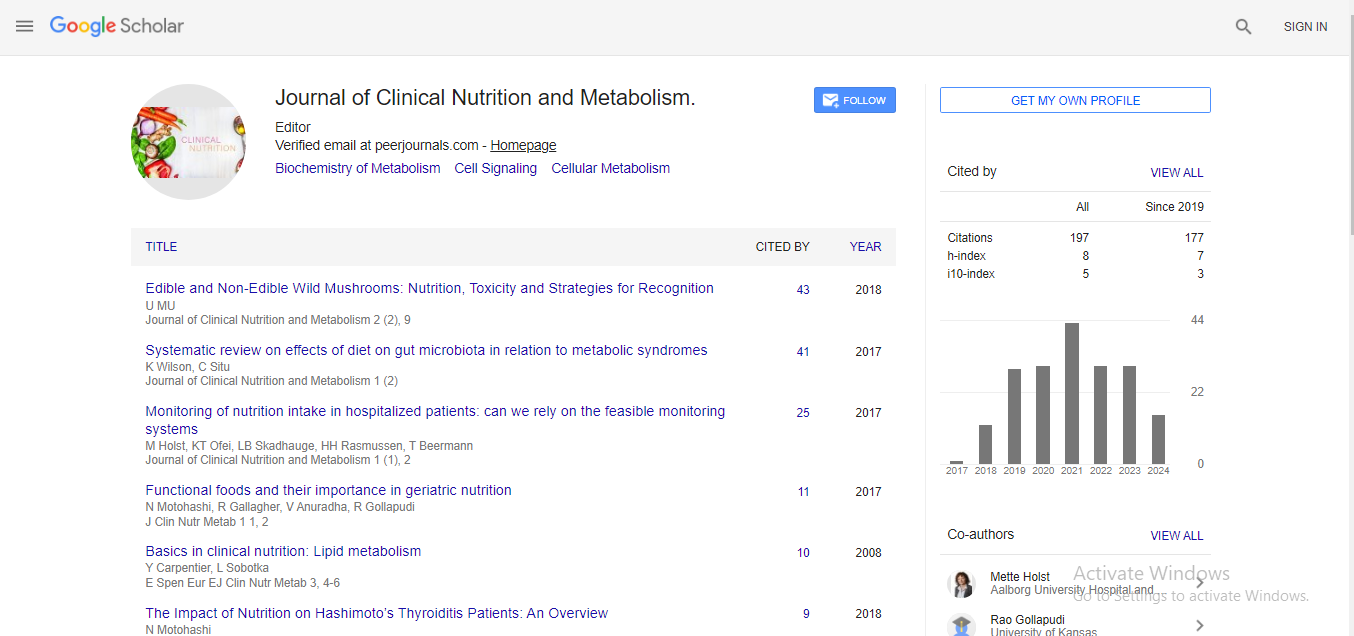Editorial, J Clin Nutr Metab Vol: 5 Issue: 5
Note on Cellular Signalling
Paulte Nourds*
Center of Research Excellence in Nanotechnology, King Fahd University of Petroleum and Minerals, Saudi Arabia
*Corresponding Author:
Paulte Nourds
Center of Research Excellence in Nanotechnology, King Fahd University of Petroleum and Minerals, Saudi Arabia
Received Date: September 13, 2020; Accepted Date: September 17, 2021; Published Date: September 21, 2021
Citation: Nourds P (2021) Note on Cellular Signalling. J Clin Nutr Metab 5:5. e112.
Copyright: © All articles published in Journal of Clinical Nutrition and Metabolism are the property of SciTechnol and is protected by copyright laws. Copyright © 2020, SciTechnol, All Rights Reserved.
Editorial
In biology, cell communication (cell signaling in British English) or cell communication is that the ability of a cell to receive, process, and transmit signals with its setting and with itself. It’s an elementary property of all cells in each living organism like bacterium, plants, and animals. Signals that originate from outside a cell (or living thing signals) may be physical agents like mechanical pressure, voltage, temperature, light, or chemical signals (e.g., little molecules, peptides, or gas). Chemical signals may be hydrophobic or hydrophilic. Cell communication will occur over short or long distances, and as a result may be classified as anticrime, juxtacrine, intracranial, paracrine, or endocrine. Communication molecules may be synthesized from varied synthesis pathways and discharged through passive or active transports, or perhaps from cell injury. Receptors play a key role in cell communication as they’re able to sight chemical signals or physical stimuli. Receptor area unit usually proteins settled on the cell surface or at intervals the inside of the cell like the protoplasm, organelles, and nucleus. Cell surface receptors typically bind with living thing signals (or ligands), that causes a conformational modification within the receptor that leads it to initiate enzyme activity, or to open or shut particle channel activity. Some receptors don’t contain catalyst or channel-like domains however area unit instead connected to enzymes or transporters. Different receptors like nuclear receptors have a distinct mechanism like ever-changing their deoxyribonucleic acid binding properties and cellular localization to the nucleus. Signal transduction begins with the transformation (or transduction) of an indication into a chemical one, which may directly activate AN particle channel (ligand-gated particle channel) or initiate a second traveler system cascade that propagates the signal through the cell. Second traveler systems will amplify an indication, within which activation of a couple of receptors ends up in multiple secondary messengers being activated, thereby amplifying the initial signal (the initial messenger). The downstream effects of those communication pathways might embody further catalyst activities like chemical process cleavage, phosphorylation, methylation, and ubiquitinylation. Every cell is programmed to retort to specific living thing signal molecules, and is that the basis of development, tissue repair, immunity, and physiological state. Errors in communication interactions might cause diseases like cancer, pathology, and polygenic disorder.
In several little organisms like bacterium, assemblage sensing permits people to start AN activity only if the population is sufficiently giant. This communication between cells was initial determined within the marine bacteria Aliivibrio fishery that produces lightweight once the population is dense enough. The mechanism involves the assembly and detection of a communication molecule, and also the regulation of factor transcription in response. Assemblage sensing operates in each gram-positive and gram-negative bacterium, and each at intervals and between species. In slime molds, individual cells called amoebae combination along to make mature bodies and eventually spores, beneath the influence of a chemical signal, originally named abrasion. The people move by taxis, i.e. they’re attracted by the chemical gradient. Some species use cyclic AMP because the signal; different like Polysphondylium violaceum use other molecules, in its case N-propionic-gamma-L-glut amyl-L-ornithine-delta-lactam alkyl organic compound, nicknamed florin. In plants and animals, communication between cells happens either through unleash into the living thing house, divided in paracrine communication (over short distances) and endocrine communication (over long distances), or by direct contact, called juxtacrine communication (e.g., notch signaling). Autocuing communication could be a special case of paracrine communication wherever the secreting cell has the power to retort to the secreted communication molecule. Conjunction communication could be a special case of paracrine communication (for chemical synapses) or juxtacrine communication (for electrical synapses) between neurons and target cells.
 Spanish
Spanish  Chinese
Chinese  Russian
Russian  German
German  French
French  Japanese
Japanese  Portuguese
Portuguese  Hindi
Hindi 